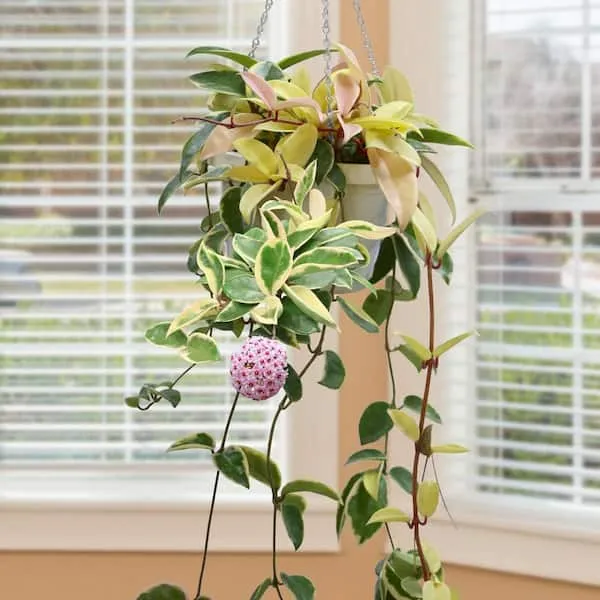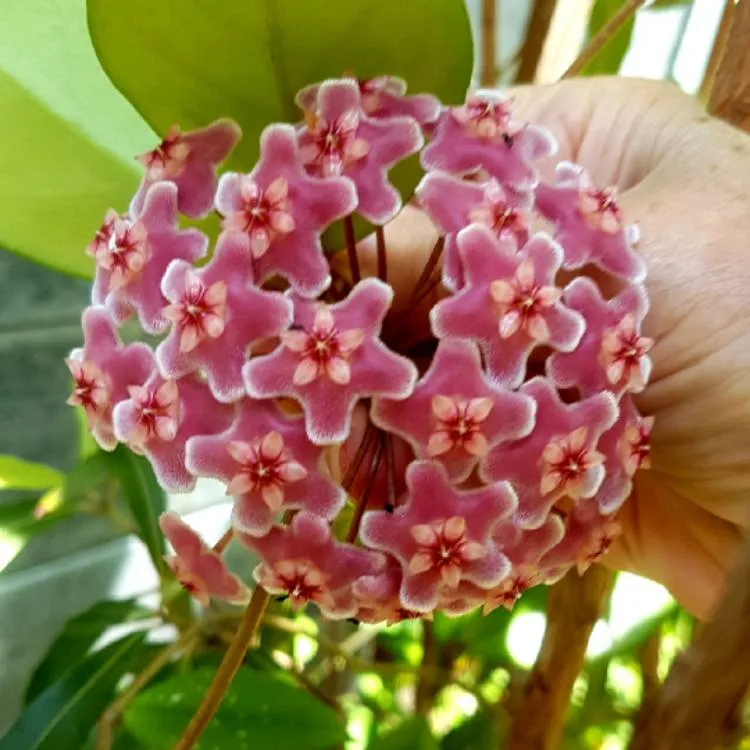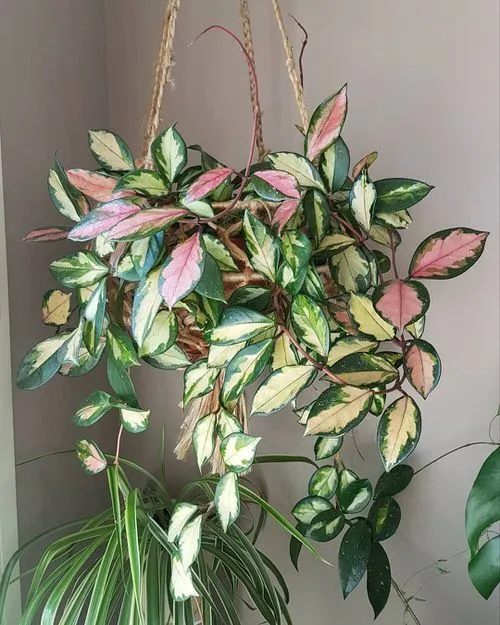How To Grow And Care Hoya Krimson Queen

The Hoya Krimson Queen, often referred to as the variegated Hoya Carnosa, is a highly sought-after houseplant known for its striking beauty and relatively easy care. This plant features stunning leaves with creamy white, pink, and green variegation, making it a standout in any plant collection. Native to tropical and subtropical regions, the Hoya Krimson Queen belongs to the Asclepiadaceae family, commonly known as the milkweed family.
Planting Hoya Krimson Queen
Choosing the Right Spot: Indoors vs. Outdoors
When deciding where to place your Hoya Krimson Queen, it’s important to consider its natural habitat. While it can be grown both indoors and outdoors, the plant is best suited for indoor environments where temperature and humidity can be controlled. Indoors, the Hoya Krimson Queen should be placed in a spot that receives bright, indirect light, such as near a window with filtered sunlight.
Soil Preparation: Importance of Well-Draining Soil
Proper soil preparation is key to the success of your Hoya Krimson Queen. This plant thrives in well-draining soil that mimics its natural epiphytic conditions. A mix of orchid bark, perlite, and peat moss is ideal, as it provides the necessary aeration and drainage while retaining enough moisture to keep the roots hydrated. Adding some charcoal to the mix can help absorb excess moisture and prevent root rot.
Planting Steps: Step-by-Step Guide with Personal Experience
- Prepare the Pot: Choose a pot with drainage holes to prevent water from accumulating at the bottom. Fill the pot halfway with your well-draining soil mix.
- Position the Plant: Carefully remove the Hoya Krimson Queen from its nursery pot, gently loosening the roots if they are tightly bound. Place the plant in the center of the new pot, ensuring it sits at the same depth as it was in the previous pot.
- Fill with Soil: Add more soil around the plant, pressing it down lightly to eliminate air pockets. Avoid burying the stem too deep, as this can lead to rot.
- Watering: Water the plant thoroughly, allowing excess water to drain out of the bottom. Wait until the top inch of soil is dry before watering again to prevent overwatering.
In my personal experience, repotting the Hoya Krimson Queen during the early spring has led to the best results, as the plant is entering its active growing season and can quickly establish itself in the new soil.
You May Also Like: Simple Tips to Grow and Care for Hoya Australis Easily
Hoya Krimson Queen Care

Light
The Hoya Krimson Queen thrives in bright, indirect light. Too little light can result in dull, green leaves with minimal variegation, while too much direct sunlight can cause leaf burn. For optimal growth, place your plant near an east or west-facing window where it can receive plenty of filtered sunlight throughout the day. If natural light is insufficient, especially during the winter months, consider supplementing with a grow light.
Water
Watering the Hoya Krimson Queen requires a careful balance. This plant prefers to dry out slightly between waterings, so it’s crucial not to overwater. During the growing season (spring and summer), water the plant thoroughly once the top inch of soil feels dry to the touch. In the fall and winter, reduce watering frequency as the plant’s growth slows down.
Temperature and Humidity
The Hoya Krimson Queen thrives in temperatures between 60°F and 80°F (16°C to 27°C). It can tolerate slightly lower temperatures but should be protected from drafts and cold air, especially during the winter months. In terms of humidity, this plant prefers a range of 40% to 60%. If your home is particularly dry, especially in winter, using a humidifier or placing the plant on a humidity tray can help maintain optimal levels.
Fertilizer
Feeding your Hoya Krimson Queen is essential for promoting healthy growth and vibrant flowering. During the growing season, apply a balanced, water-soluble fertilizer every four to six weeks. A 10-10-10 or 20-20-20 fertilizer works well, providing the necessary nutrients for foliage and flower development. In my experience, it’s best to dilute the fertilizer to half strength to avoid over-fertilizing, which can lead to salt buildup in the soil and damage the roots. During the fall and winter, reduce feeding to once every two months or stop altogether, as the plant’s growth slows down.
Pruning
Pruning the Hoya Krimson Queen is not only beneficial for maintaining its shape but also for encouraging new growth. The best time to prune is in the spring, just before the plant enters its active growing season. Using sharp, sterile scissors, trim back any leggy or unruly vines, making cuts just above a node (where the leaf meets the stem). Pruning also helps remove any dead or damaged leaves, which can otherwise drain the plant’s energy.
Popular Varieties of Hoya Krimson Queen
List and Description of Popular Varieties
While the Hoya Krimson Queen itself is a variety of Hoya Carnosa, there are several other popular Hoya varieties that enthusiasts often grow alongside it:
- Hoya Krimson Princess: Similar to the Krimson Queen but with reversed variegation, where the leaf margins are green and the center is creamy white or pink.
- Hoya Carnosa: The non-variegated version with solid green leaves, known for its resilience and ease of care.
- Hoya Compacta: Also known as the Hindu Rope, this variety has curled, compact leaves that give it a unique, rope-like appearance.
- Hoya Obovata: Recognized for its round, dark green leaves with silver speckles, this variety is a favorite for its striking foliage and ease of growth.
Each of these varieties offers something unique, whether it’s the leaf shape, color, or growth habit, making them all popular choices among Hoya enthusiasts.
Propagating Hoya Krimson Queen

Methods: Detailed Propagation Techniques
Propagating the Hoya Krimson Queen is a rewarding process that allows you to create new plants from cuttings. The most common method is through stem cuttings, which can be rooted in water or directly in soil:
- Water Propagation: Cut a healthy vine with at least two leaves and place it in a jar of water, ensuring that at least one node is submerged. Change the water every few days to prevent stagnation. Roots should begin to form within a few weeks, after which the cutting can be transferred to soil.
- Soil Propagation: Take a cutting as described above and dip the cut end in rooting hormone to encourage root growth. Plant the cutting in a pot filled with a well-draining soil mix, and keep it in a warm, humid environment. Water sparingly until new growth appears.
In my experience, propagating the Hoya Krimson Queen in water has been the most successful method. I usually place the jar near a bright, indirect light source, which seems to speed up the rooting process. Once the roots are about an inch long, I transplant the cutting into soil and keep it covered with a plastic bag for the first week to maintain high humidity. This method has consistently resulted in healthy, thriving new plants.
Potting and Repotting
Choosing the Right Pot: Best Types of Pots
Selecting the right pot is crucial for the health of your Hoya Krimson Queen. Since this plant prefers well-draining soil, a pot with drainage holes is essential. Terracotta pots are a great choice as they allow for better airflow to the roots and help prevent overwatering. Plastic pots can also be used, but be sure to monitor the soil moisture closely, as they tend to retain more water.
Repotting Steps
Repotting your Hoya Krimson Queen should be done every two to three years or when the plant becomes root-bound. The best time to repot is in the spring, just before the growing season begins:
- Choose a New Pot: Select a pot that is one size larger than the current one, ensuring it has drainage holes.
- Prepare the Soil: Mix fresh, well-draining soil as described earlier.
- Remove the Plant: Gently remove the plant from its current pot, loosening the roots if they are tightly bound.
- Replant: Place the plant in the new pot, fill in with fresh soil, and water thoroughly.
In my experience, repotting in the spring has led to vigorous growth and more abundant flowering. After repotting, I usually place the plant in a slightly shaded area for a few days to help it adjust to its new environment.
Common Pests & Plant Diseases in Hoya Krimson Queen

Pest Identification
The Hoya Krimson Queen, while generally resistant to pests, can occasionally be affected by common houseplant pests such as:
- Mealybugs: These appear as white, cottony clusters on the leaves and stems. They feed on plant sap and can cause stunted growth.
- Spider Mites: Tiny, red or brown mites that create fine webbing on the undersides of leaves. They thrive in dry conditions and can cause yellowing of the leaves.
- Aphids: Small, green or black insects that cluster on new growth. They also feed on sap and can lead to deformed leaves.
Disease Identification: Common Diseases and Symptoms
The Hoya Krimson Queen is relatively hardy but can fall victim to a few common diseases:
- Root Rot: Caused by overwatering and poor drainage, root rot results in blackened, mushy roots and wilting leaves.
- Leaf Spot: Fungal or bacterial spots on the leaves that appear as brown or black lesions. This can be caused by high humidity and poor air circulation.
- Powdery Mildew: A white, powdery substance on the leaves, caused by high humidity and low airflow.
Treatment and Prevention
To prevent and treat pests and diseases on your Hoya Krimson Queen, consider the following strategies:
- Mealybugs and Aphids: Use a cotton swab dipped in rubbing alcohol to remove visible pests. For severe infestations, treat the plant with insecticidal soap or neem oil.
- Spider Mites: Increase humidity around the plant and regularly mist the leaves. If mites persist, apply a miticide or insecticidal soap.
- Root Rot: Ensure proper drainage and allow the soil to dry out between waterings. If root rot is suspected, remove the plant from its pot, trim away the affected roots, and repot in fresh, dry soil.
- Leaf Spot and Powdery Mildew: Improve air circulation by spacing plants apart and avoid overhead watering. Fungicides can be applied for severe cases, but prevention through proper care is the best approach.
Troubleshooting Common Problems

Poor Flowering
If your Hoya Krimson Queen isn’t flowering, it may be due to insufficient light or improper feeding. Ensure the plant is receiving bright, indirect light and consider supplementing with a balanced fertilizer during the growing season. Another factor could be the age of the plant, as Hoyas often take several years to mature and bloom.
Yellowing Leaves
Yellow leaves can indicate overwatering, nutrient deficiencies, or inadequate light. Check the soil moisture and adjust your watering schedule if necessary. If the plant is in low light, consider moving it to a brighter location. Additionally, a balanced fertilizer can help address any nutrient deficiencies.
Stunted Growth
Stunted growth is often a sign of root issues, such as being root-bound or suffering from root rot. Check the roots and repot if necessary. Ensuring the plant has enough light and nutrients can also help promote healthy growth.
Fungal Infections
Fungal infections, such as leaf spot and powdery mildew, are usually caused by high humidity and poor air circulation. Improving ventilation and reducing humidity levels can prevent these issues. If infection occurs, remove affected leaves and treat the plant with a fungicide.
Seasonal Care Tips
Spring and Summer
During the spring and summer, the Hoya Krimson Queen enters its active growing season. This is the best time to repot, propagate, and feed the plant. Ensure it receives plenty of bright, indirect light and water it more frequently as the soil dries out faster in warmer weather.
Fall and Winter
In the fall and winter, the Hoya Krimson Queen’s growth slows down, and it enters a period of dormancy. Reduce watering and stop feeding during this time. The plant may still benefit from bright light, but avoid placing it near cold drafts or in overly dry conditions.
Conclusion
The Hoya Krimson Queen is a stunning and relatively easy-to-care-for houseplant that brings a touch of tropical elegance to any home. With its striking variegated leaves and fragrant flowers, it’s no wonder this plant is a favorite among both novice and experienced gardeners. By following the care tips outlined in this guide, you can enjoy a healthy, thriving Hoya Krimson Queen for years to come. Whether you’re growing it indoors or out, with proper light, soil, and care, this plant is sure to become a cherished part of your collection.
